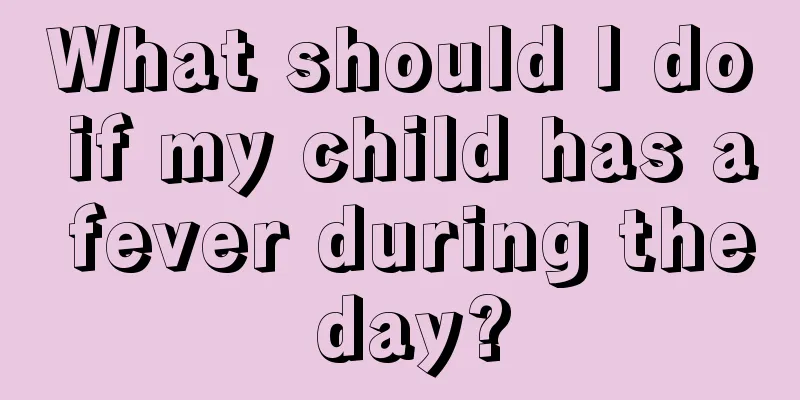What should I do if my child has a fever during the day?

|
It is not so rare for children to have a fever. In our daily life, we often see many children suffering from colds, fevers, runny noses, coughs, etc. But although these situations seem common, they make every mother feel very difficult. Mothers feel particularly happy when they take care of their children themselves, but they are also worried that their children will get sick. What should I do if my child has a fever during the day? Generally speaking, there are three types of baby fever: low fever 37.5 degrees Celsius - 38 degrees Celsius; moderate fever 38.1 degrees Celsius - 39 degrees Celsius; high fever 39.1 degrees Celsius - 40 degrees Celsius. Generally speaking, if the baby's body temperature is below 38.5℃, and he is not feeling particularly uncomfortable and in good spirits, that is, he eats, sleeps and plays as usual, the mother does not need to rush to give the baby medicine, and physical cooling is more appropriate. Recommended method: Don’t cover your baby’s sweat blindly: Some parents believe that covering their baby’s fever will help him get better faster. But in fact, it is not easy to dissipate body heat in this way, especially in the hot summer, it is easy to get "heatstroke". For infants under 3 months old, opening their clothes and quilts and letting them wear less clothes may have the effect of gradually reducing their temperature. Generally speaking, babies with high fever should not be covered with thick quilts and should wear less clothes. Wiping the body to cool down: Mothers can use 75% alcohol and add an appropriate amount of warm water to physically cool the baby down. However, it should be noted that alcohol can be used to wipe the forehead, armpits, thighs and neck, but never the chest. Drink more water and urinate: Babies with fever should drink more water to increase urine volume, which can promote the excretion of toxins in the body. At the same time, attention should be paid to replenishing the electrolytes lost by the body. Mothers can let the baby drink some glucose water or light salt water appropriately. Warm and wet compress: Apply a large warm, wet, and semi-dry towel to the baby's chest and abdomen, but be careful not to turn on the air conditioner to prevent the room temperature from being too low and causing a chill that worsens the cold. In addition, you can also use a few slightly cool wet towels (about 25℃), wring them into half dry, and place them on the baby's forehead, neck, armpits and thighs for cold compress. Change them every 5 to 7 minutes. The cool feeling can make the baby much more comfortable. In fact, it is quite common for children to have a fever, so there is no need to panic too much. Parents in particular must not panic and try all kinds of medical treatments in a hurry. This is not good for the child's health. In normal times, we should strengthen children's immunity and resistance through diet and exercise, which will also reduce the chances of illness and keep children healthy. |
<<: What causes my child’s swollen eyelids?
>>: What are some good appetizers for kids?
Recommend
What is the best food for children with anal prolapse
If a child has rectal prolapse, parents can help ...
Children's abdominal B-ultrasound lymph node enlargement
Swollen lymph nodes in the abdomen is a very comm...
Why does my child’s poop smell so bad?
Feces are waste and garbage discharged by our hum...
Why does my child breathe heavily when sleeping?
When young mothers are taking care of their babie...
Reasons why newborns hum when they sleep
As we all know, the physical health of newborns i...
What should I do if my child has a poor appetite recently?
I believe that for parents with children, the mos...
What to do if your child has low intelligence
Many children are prone to problems when they are...
What is the reason for the baby's sudden loss of appetite?
Babies are prone to many diseases. When treating ...
Early symptoms of convulsions in children
Unlike adults, children's organs are not full...
What is the head circumference of a three month old baby?
In life we often say that people with big heads...
What can children eat to grow taller?
A child’s height and nutrition are closely relate...
What should children eat when they have tracheitis and cough?
Coughing is a more obvious symptom in children su...
At what age can a child eat by himself
As children grow up, they will gradually learn va...
How to treat urinary tract infection in children?
When it comes to urinary tract infection, perhaps...
One and a half year old baby has small granules on his chin
A baby's body is very different from that of ...









